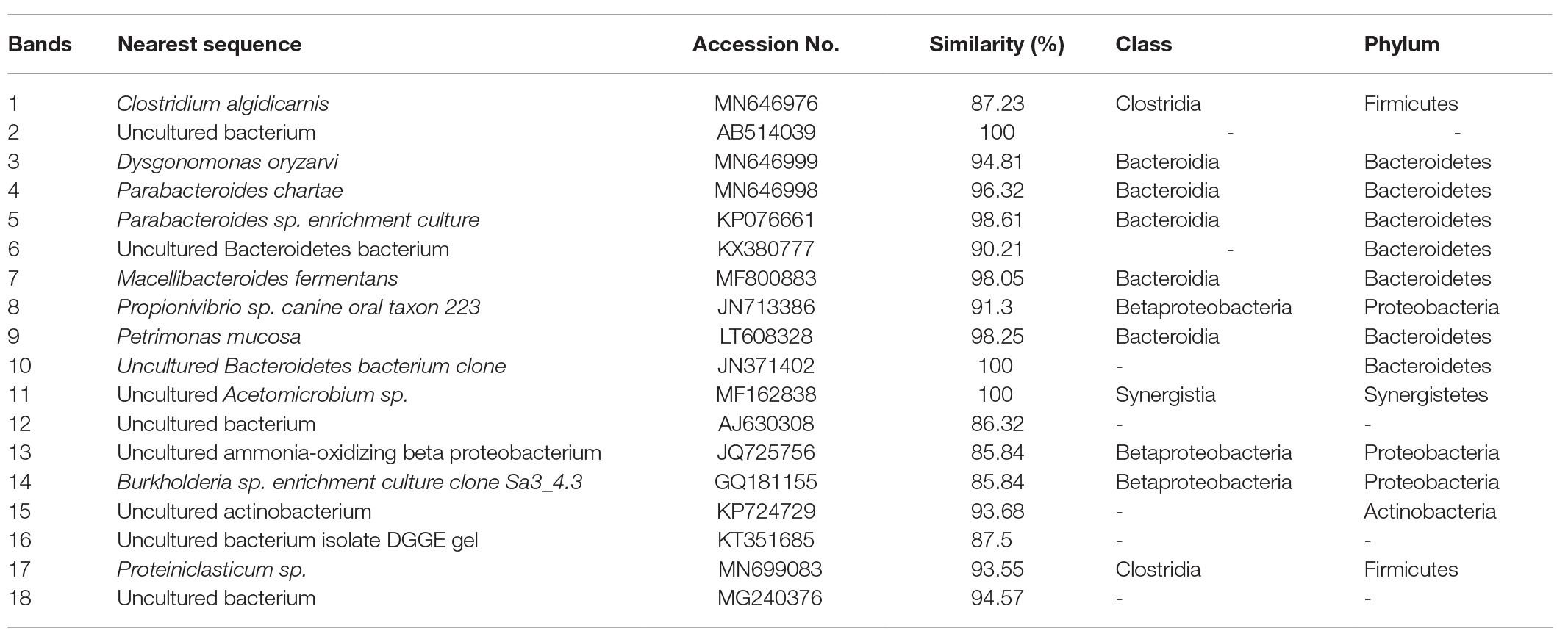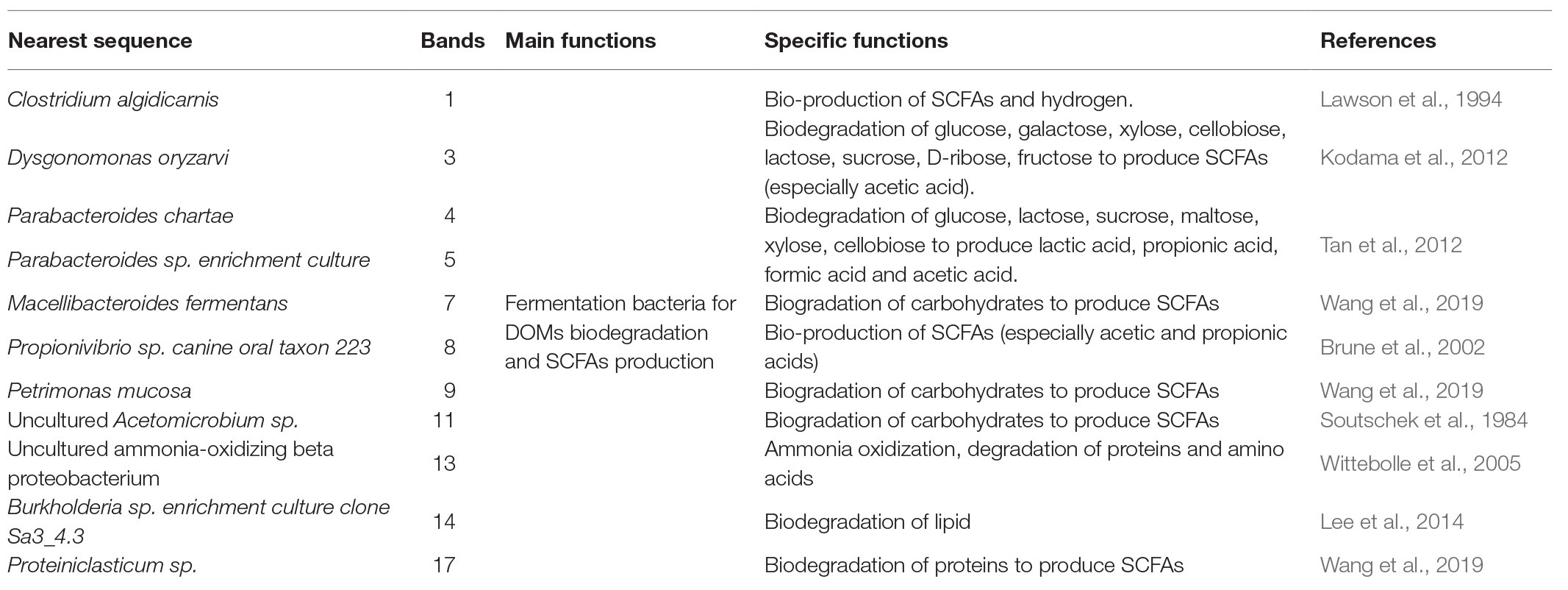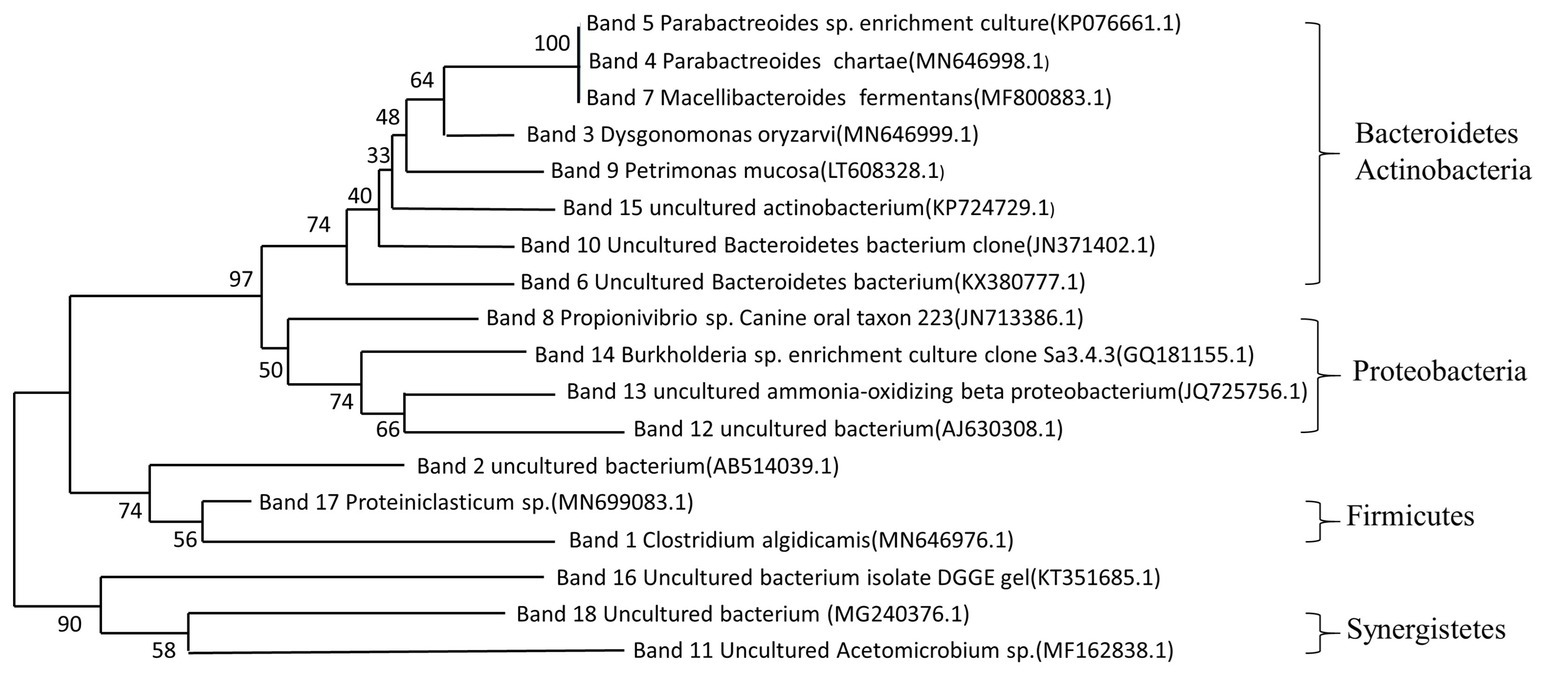- 1School of Environmental Science and Engineering, Huazhong University of Science and Technology, Wuhan, China
- 2School of Environment, Harbin Institute of Technology, Harbin, China
- 3Department of Environmental Science and Engineering, Huaqiao University, Xiamen, China
- 4School of Civil Engineering, Guangzhou University, Guangzhou, China
- 5Advanced Environmental Biotechnology Centre, Nanyang Environment and Water Research Institute, Nanyang Technological University, Singapore, Singapore
- 6College of Civil Engineering, Fuzhou University, Fuzhou, China
- 7Frog Biotechnology Co., LTD, Harbin, China
Previous studies have demonstrated that sludge hydrolysis and short-chain fatty acids (SCFAs) production were improved through NaCl assistant anaerobic fermentation. However, the effect of NaCl concentrations on hydrolase activity and microbial community structure was rarely reported. In this study, it was found that α-glucosidase activity and some carbohydrate-degrading bacteria were inhibited in NaCl tests, owing to their vulnerability to high NaCl concentration. Correspondingly, the microbial community richness and diversity were reduced compared with the control test, while the evenness was not affected by NaCl concentration. By contrast, the protease activity was increased in the presence of NaCl and reached the highest activity at the NaCl concentration of 20 g/L. The protein-degrading and SCFAs-producing bacteria (e.g., Clostridium algidicarnis and Proteiniclasticum) were enriched in the presence of NaCl, which were salt-tolerant.
Introduction
It is estimated that China’s total waste activated sludge (WAS) production will reach 60 million tons by 2020 (Li et al., 2018). The disposal of WAS has become a global problem. The yield of WAS had reached or even exceeded the environmental load, which increased environmental risks and disposal costs (Sun et al., 2015; Chen et al., 2019; He et al., 2019; Zhang et al., 2019). In recent years, carbon recovery in anaerobic fermentation has attracted wide attention (Cheng et al., 2020; Pang et al., 2020d). Through anaerobic fermentation process, biodegradable organic matter in WAS can be converted into short-chain fatty acids (SCFA), which was a promising carbon source with a wide range of applications (Zhang et al., 2018, 2020; Xin et al., 2020). For example, it could be used as an external carbon source to supplement the carbon gap in wastewater treatment plants (WWTPs) and to promote the biological production of electricity/polyhydroxyalkanoate (PHA; Cai et al., 2009; Li et al., 2011; Chen et al., 2013). Generally, hydrolysis and acidification were involved in anaerobic fermentation for SCFAs production (Luo et al., 2019). The hydrolysis step was regarded as the rate-limiting stage, as the biodegradable organic matters were wrapped in WAS flocs, which reduced their usability for microorganism (Lv et al., 2010). As such, WAS solubilization with the aim of organic matter release was necessary for improving anaerobic fermentation efficiency.
NaCl (sodium chloride) is an inexpensive chemical with a wide range of sources. It has been reported that high NaCl concentration could induce sludge solubilization and deteriorate floc structure (Reid et al., 2006; Cui et al., 2015; Su et al., 2016; Lu et al., 2019). In our previous research, a novel and efficient NaCl assistant anaerobic fermentation strategy was developed for bio-production of SCFAs (Pang et al., 2020e). In the process of NaCl assistant anaerobic fermentation, the addition of NaCl resulted in significant osmotic pressure difference between the sludge phase and the liquid phase, which caused the decomposition of WAS flocs and the breakdown of extracellular polymeric substances (EPS). As such, the sludge flocs were dissolved with release of biodegradable organic matter. Thereby, the efficiencies of sludge hydrolysis and the subsequent SCFAs production were improved. It was reported that numerous soluble chemical oxygen demand (SCOD) of 4,092 mg/L was released into the supernatant at the optimal NaCl concentration of 20 g/L, meanwhile considerable SCFAs of 288.2 mg COD/g VSS was produced through a 4-day anaerobic fermentation (Pang et al., 2020e). Such performances on sludge solubilization and SCFAs yield in NaCl assistant anaerobic fermentation were comparable to the anaerobic fermentation with chemical pretreatments (e.g., surfactants, enzymes, cation-exchange resin, etc.; Huang et al., 2015; He et al., 2018; Pang et al., 2020a,b, 2021).
Furthermore, numerous NaCl was remained in the fermented sludge, which was feasible for reuse once the produced SCFAs could be utilized and consumed. As declared in previous study, the NaCl assistant anaerobic fermentation was indeed a green and efficient approach with some advantages, e.g., none irresistibly consumed chemicals, considerably reduced treatment costs and avoided environmental risks of remained NaCl. After NaCl assistant anaerobic fermentation, the fermentative liquid with numerous SCFAs could be used as external carbon source, e.g., the substrate for biological electricity production through microbial fuel cell (MFC) or the external carbon source for supplementing the carbon gap in municipal wastewater. The feasibility of these utilization approaches were discussed in our previous study (Pang et al., 2020e). After utilization of the soluble organic matters, the fermentative liquid could be reused for NaCl assistant anaerobic fermentation since there is numerous NaCl existed in the fermentative liquid. In this way, the treatment agent (i.e., NaCl) could be recycled, implying that considerable chemical agent and treatment costs could be saved.
Despite the sludge solubilization, EPS disruption, SCFA yield, and relevant mechanism were explored in our previous study (Pang et al., 2020e); the effects of NaCl concentration on enzyme activity and microbial community structure are still unfathomed. Actually, the tolerance of bacteria for high salinity condition is different. The harsh condition of high NaCl concentration might not be conducive to the survival of some microorganism in WAS, which was related to microbial community structure and might lead to shift of dominant bacterial community (Duan et al., 2016). In ecosystem, the functional bacteria distribution is critical to the system functions (Xin et al., 2015; Xu et al., 2018, 2019; Ji et al., 2020). In the anaerobic fermentation process, both the biodegradation of dissolved organic matters (DOMs) and the consumption of SCFAs mainly rely on appropriate microbial communities. As such, exploring the hydrolase activity and microbial community structure under different NaCl concentrations were beneficial to completely understand the NaCl assistant anaerobic fermentation process and optimize the process parameters. Furthermore, the evolutions of microbial community structure and metabolic activity at different NaCl concentrations during anaerobic fermentation process have rarely attracted our attention. Under this circumstance, the functional characteristics of the sludge ecosystem and the biodegradation pathway of DOMs were seriously affected, which might be varying at different NaCl concentrations and be dissimilar to that in conventional anaerobic fermentation (without NaCl addition). The microbial and enzymic characteristics of sludge related to different NaCl concentration in NaCl assistant anaerobic fermentation might be an interesting issue.
In this study, the microbiological characteristics at different NaCl concentrations were explored in the anaerobic fermentation system. The main objectives of this research include (1) investigating the effect of NaCl concentrations on hydrolase activity in anaerobic fermentation process; (2) exploring the microbial community structure and identifying main species at different NaCl concentrations; and (3) analyzing biodegradation pathway of DOMs for SCFAs accumulation in NaCl assistant anaerobic fermentation process. Through this research work, we can further understand the metabolic activity and microbial community structure related to different NaCl concentrations during anaerobic fermentation, which improved the knowledge of community ecology.
Materials and Methods
Characteristics of Thickened WAS
The WAS samples were obtained from a municipal WWTP locating in Harbin city, Heilongjiang province, China. The collected WAS samples were thickened at 4°C for 12 h, which was then used for the anaerobic fermentation experiments. The total suspended solids (TSS), volatile suspended solids (VSS), and total chemical oxygen demand (TCOD) of the thickened WAS were 19.2 ± 0.2, 13.2 ± 0.1, and 17.1 ± 0.3 g/L, respectively. The sludge pH was 6.95 ± 0.15. In the initial supernatant, the SCOD concentration, soluble proteins content, soluble polysaccharides content, and SCFAs concentration were 240 ± 85, 62.2 ± 12.7, 26.6 ± 5.8, and 45.7 ± 30.0 mg COD/L, respectively.
Anaerobic Fermentation Experiment
The NaCl assistant anaerobic fermentation was performed in four batch reactors (working volume = 500 ml) and 450 ml thickened WAS was filled each. The NaCl agent (AR) was added into these batch reactors to adjust the NaCl concentrations to 0 (control), 10, 20, and 30 g/L, respectively. Then, these reactors were flushed with N2 and were stirred in an air-bath shaker at 120 rpm (35 ± 1°C). The sludge samples were collected on day 4 of the anaerobic fermentation for the analyses of hydrolase activity and microbial community. The sludge pH during the NaCl assistant anaerobic fermentation process was in the range of 6.7–7.0, without adjustment. The fermentation period (4 days) was selected according to our previous study, in which the sludge samples and experimental conditions were the same. In our previous study, the optimal period of NaCl assistant anaerobic fermentation was found to be 4 days (Pang et al., 2020e). The experimental results are averaged in triplicates.
Hydrolase Activities
The protease and α-glucosidase activities were measured following the procedures in existing literatures (Liu et al., 2015). The Tris-HCl buffer (pH = 8) and Triton X-100 were employed for extracting the protease from sludge samples. The protease extraction solution was used for protease activity quantification, while the sludge samples were used for α-glucosidase activity measurement. The measurement procedure of hydrolase activity was the same for different sludge samples.
Denaturing Gradient Gel Electrophoresis Analysis
The Fast DNA Spin Kit-EZ-10 was used to extract total DNA according to the method described in specification. After the successful extraction by gel electrophoresis, the DNA was stored in a refrigerator (−20°C) for further processing. The GeneAmp PCR System 9700 (PE9700, ABI, USA) was used to amplify 16S rRNA genes, the steps were as follows: denaturation (95°C, 30 s), denaturation (94°C, 45 s), annealing (60°C, 45 s), extension (72°C, 60 s), and extension (72°C, 600 s). Primers 338F (FACTCCTACGGGAGGCAGC) and 518R (ATTACCGCGGCTGCTGG) were used for gene amplification. Electrophoresis was carried out using buffer (1 × TAE, 80 V, 60°C, 720 min). Then, the gel was stained with SDNA-nucleic acid staining dye (Bio Basic Inc., Canada), followed by washing with sterile water and scanning using a projection scanner (PowerLook 1,000, Umax, China). Finally, the samples were sequenced on DNA sequencing system (ABI3730XL).
In order to assess the microbial community structure at different NaCl concentrations, the richness and diversity indexes were analyzed. The denaturing gradient gel electrophoresis (DGGE) band results were analyzed by Quantity One version 4.6.2 analysis software, i.e., the band numbers and strength were determined, followed by calculation according to the procedure in previous study (Polli et al., 2018). The DGGE technology is economical and dependable, which is sufficient for analyzing the difference of microbial community structure between sludge samples. In this study, the DGGE results were expected to provide some valuable conclusions.
Results and Discussion
Effect of NaCl Concentration on Hydrolase Activity
The enzyme activity was closely related to metabolic activity of functional microorganism in sludge system, especially the hydrolase activity, which directly affects sludge hydrolysis and DOMs biodegradation in anaerobic fermentation process. During the NaCl assistant anaerobic fermentation, the additional NaCl caused remarkable osmotic pressure difference, resulting in EPS disruption and cell lysis (Pang et al., 2020d). Sludge solubilization was thereby triggered, which enhanced sludge hydrolysis and SCFAs production. Meanwhile, the high salinity environment significantly affected the survival of some microorganism, which modified microbial community structure and changed functional characteristics of sludge system. The enzyme activity was also remarkably affected. The Figure 1 presents the relative activity of hydrolase (i.e., protease and α-glucosidase) after 4-day anaerobic fermentation at different NaCl concentrations. Compared with the control test (i.e., without NaCl addition), the protease activity was significantly increased at the NaCl concentrations in range of 10–30 g/L, while the α-glucosidase activity was decreased. Overall, the presence of NaCl facilitated protease and inhibited α-glucosidase in the anaerobic fermentation system. Moreover, it was noticeable that the relative activity of protease was increased with the rising NaCl concentration from 0 to 20 g/L, afterward the protease activity gradually decreased with the further increase in NaCl concentration to 30 g/L. Apparently, 20 g/L was the optimal NaCl concentration for protease activity and hydrolysis of protein-like substances. The increasing NaCl concentration within 0–20 g/L facilitated protease secretion and improved protease activity, further increasing NaCl concentration might injure some function microbes and inhibits protease activity. In contrast, the relative α-glucosidase activity presented decrease trend with the increasing NaCl concentration. Obviously, the protease was resistant to the NaCl presence when the NaCl concentration was less than 20 g/L, whereas α-glucosidase was vulnerable to the high salinity condition. The hydrolase activity was associated with the hydrolysis efficiency of DOMs. It could be inferred that the hydrolysis of proteins was improved and the hydrolysis of carbohydrates inhibited in the NaCl assistant anaerobic fermentation.
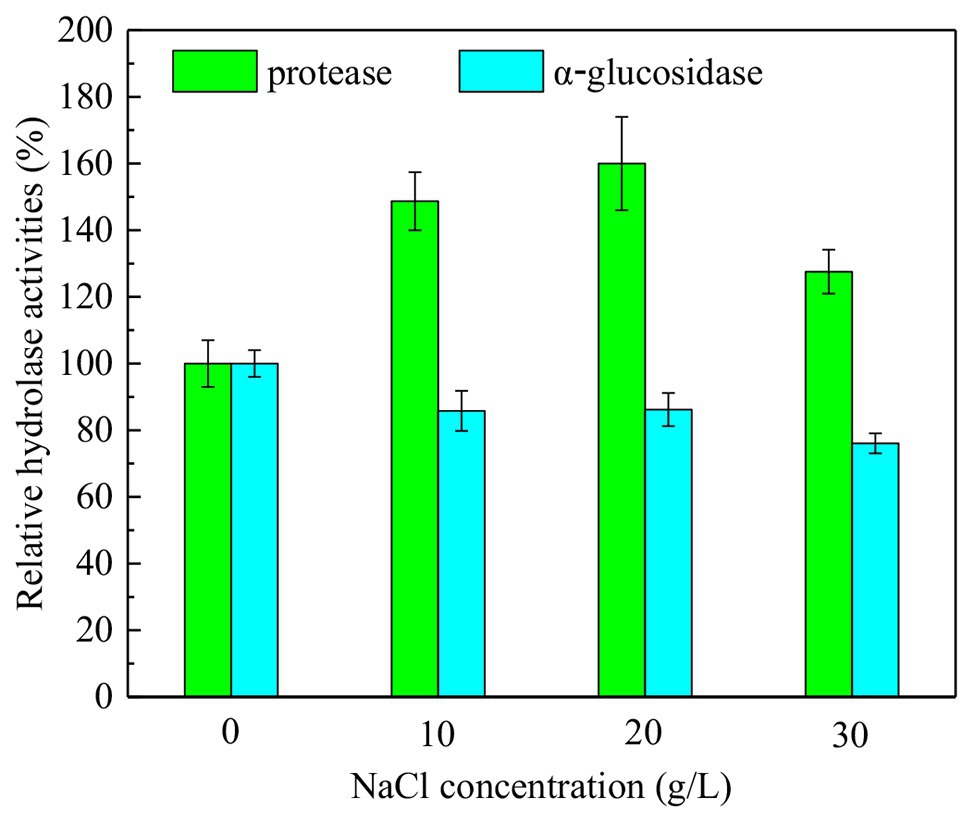
Figure 1. Relative activities of protease and α-glucosidase after 4-day NaCl assistant anaerobic fermentation at the NaCl concentrations of 0 (control), 10, 20, and 30 g/L.
Functional Microbial Community Identification: DGGE Band Analysis
To explore the effects of NaCl concentration on microbial community in NaCl assistant anaerobic fermentation process, the DGGE analysis was employed. The DGGE fingerprint at different NaCl concentrations (0–30 g/L) is presented in Figure 2A, and the DGGE diagram is provided in Figure 2B for more clear demonstration. The location and lightness of the bands represent the bacteria species and abundance, respectively. Obvious differences of bacterial species between the samples at different NaCl concentrations were observed. Moreover, the color depth and the line roughness of bands could be used for assessing bacterial abundance, i.e., the deeper color in Figure 2A and the more rough line in Figure 2B were associated with the higher bacteria abundance. This implied that the relative abundances of each bacteria were diverse with different NaCl concentrations. Figure 3 displays the microbial community distribution of the sludge samples, which also proved the diverse evolution of microbial community at different NaCl concentrations. According to the band strength and bacteria distribution in Figures 2, 3, it was observed that the bacteria species were reduced with the presence of NaCl. The abundances of the bacteria related to Band 2, 4, 5, 6, 7, 9, 13, 14, 16, and 18 were reduced with the rising NaCl concentrations, while the abundances of bacteria related to Band 1, 8, 10, 11, 12, 15, and 17 were increased.
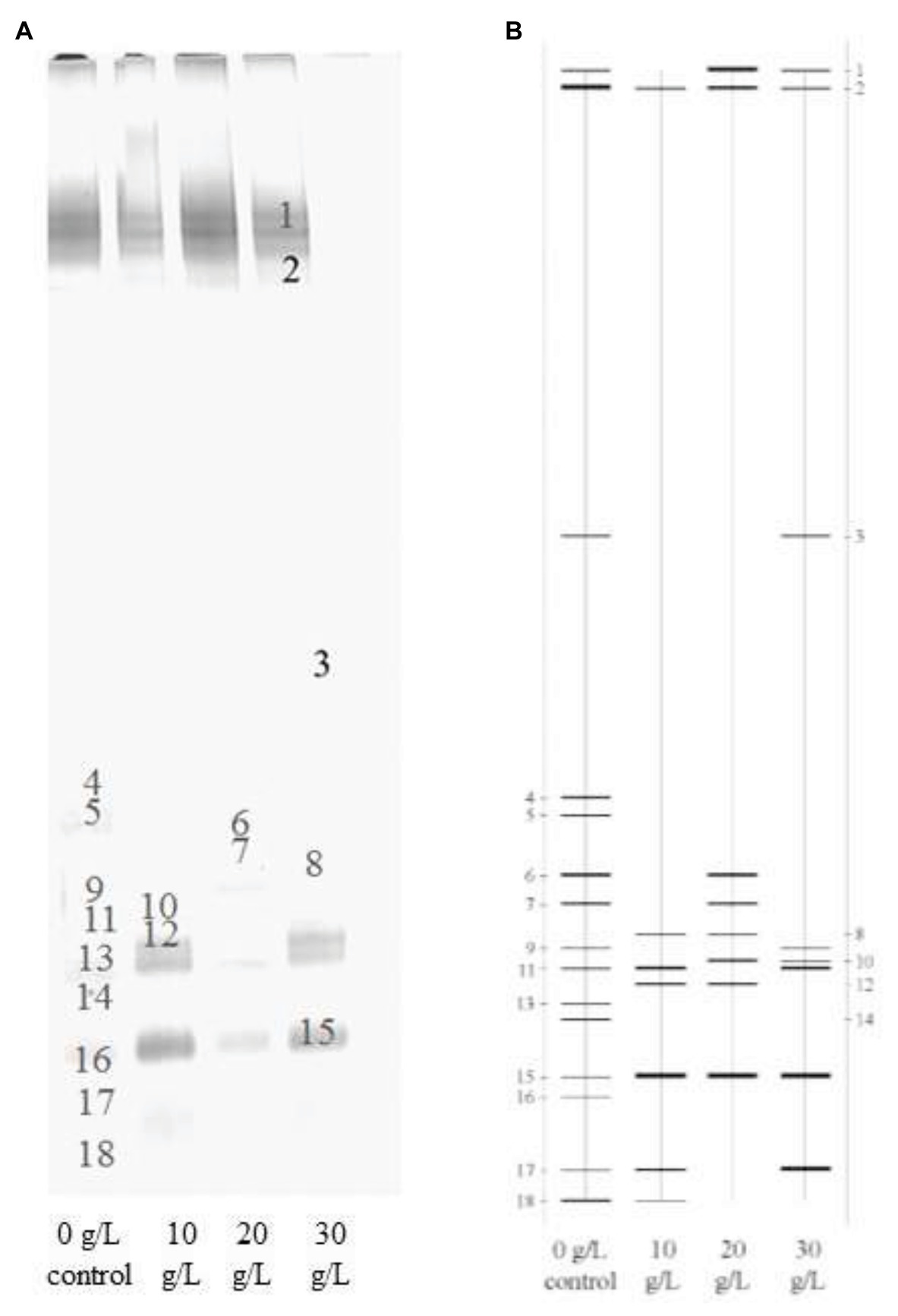
Figure 2. DGGE fingerprint of microbial communities at different NaCl concentrations of 0 (control), 10, 20, and 30 g/L: (A) DGGE profiles and (B) DGGE diagram.
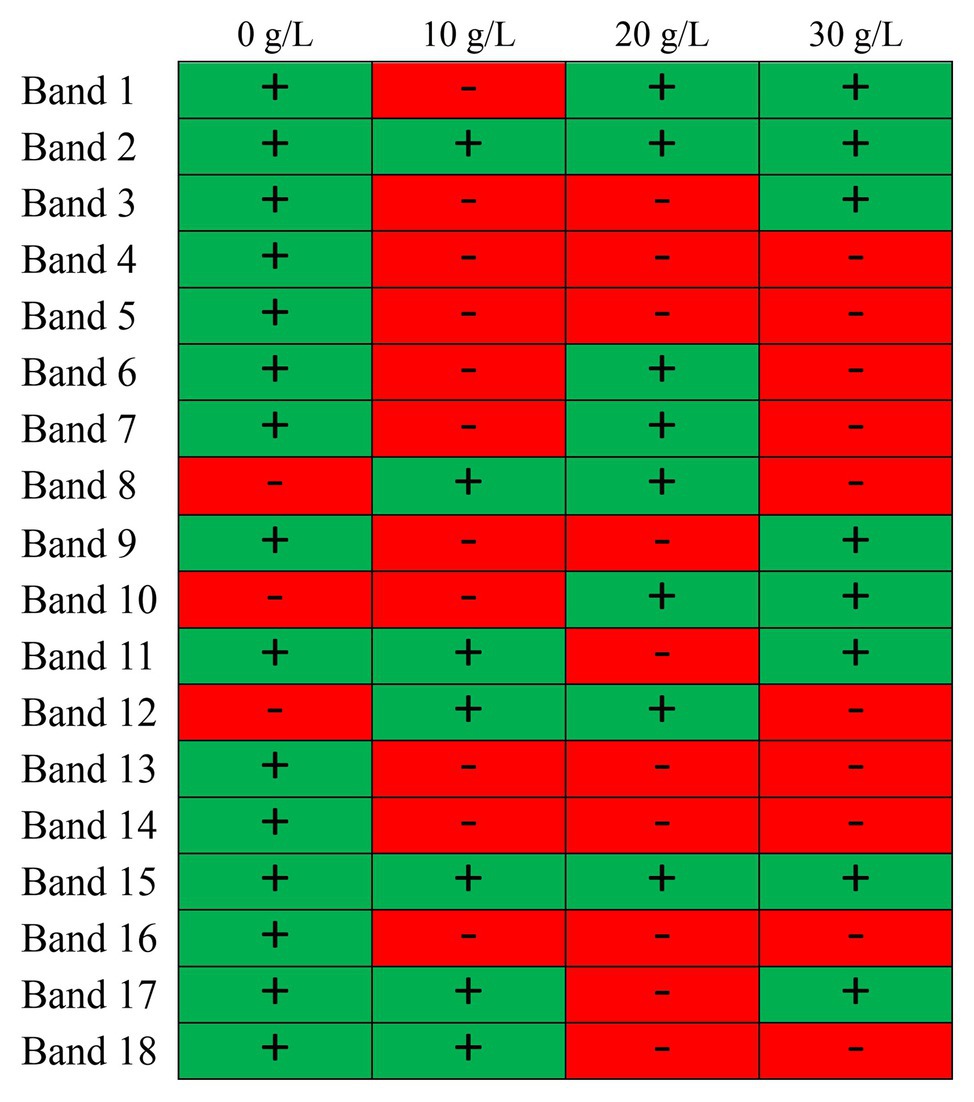
Figure 3. Illustration of bacteria distribution in NaCl assistant anaerobic fermentation system at different NaCl concentrations.
The bacteria identification of the bands from DGGE profile is shown in Table 1, and the main physiological functions of these functional bacteria are summarized in Table 2. Moreover, the neighbor-joining tree was analyzed for identifying the bacterial affiliation from DGGE band sequences to the database sequences as shown in Figure 4. The bacteria with closed distance in neighbor-joining tree implied that these two bacteria might be affiliated to the same phylum or class with similar functions. It can be seen in Figure 4 that the major phyla in the sludge system after 4-day anaerobic fermentation include Firmicutes, Bacteroidetes, Proteobacteria, Synergistetes, and Actinobacteria, which were reported to widely present in anaerobic digestion processes (Pang et al., 2020c). It was found that the phylum Proteobacteria was responsible for cell lysis, intracellular material release, and organic compound degradation (Kim et al., 2009), while Bacteroidetes could utilize the released intracellular material to carry out hydrolytic fermentation and possibly release proteinaceous EPS (Han et al., 2015). It was also reported that the Phylym Firmicutes includes extremely resistant microorganisms and endospores, which could also trigger the biodegradation of some organic compounds (Garcia et al., 2011).
Obviously, the phyla in the four sludge samples were mainly responsible for sludge hydrolysis and anaerobic fermentation. The reduced bacteria abundances might attribute to the inhibition of NaCl on bacteria growth. The inhibited bacteria were vulnerable to high salinity condition, i.e., Parabacteroides chartae, Parabacteroides, Macellibacteroides fermentans, Petrimonas mucosa, ammonia-oxidizing beta proteobacterium, and Burkholderia. It indicated that many bacteria in these genera were eliminated because they were more susceptible to the high NaCl concentration. Some research have reported that the major ecological function of Parabacteroides chartae, Macellibacteroides fermentans, and Petrimonas mucosa was the degradation of carbohydrates, which was consistent with the decreased α-glucosidase activity in Figure 1. Compared with control test (0 g/L), the genera, including Clostridium algidicarnis, Propionivibrio sp. canine oral taxon 223, uncultured Acetomicrobium sp., uncultured actinobacterium, and Proteiniclasticum sp., were enriched, which were salt-tolerant and were mostly associated with proteins biodegradation and SCFAs production. The above results revealed that the presence of NaCl during the 4-day anaerobic fermentation period caused bacteria abundance variations. The long-term exposure to high salinity condition resulted in significant reductions in some certain bacteria abundances related to carbohydrate hydrolysis, while some protein-hydrolysis bacteria and SCFAs producers were survived. The enrichment of these resistant bacteria contributed to the bio-production of SCFA and the biodegradation of proteins during the NaCl assistant anaerobic fermentation. These results indicated that the presence of NaCl changed the structural composition of microbial community, which created a good favorable environment for anaerobic fermentation. Under the condition with different NaCl concentrations, the NaCl assistant anaerobic fermentation was related to the evolution of microbial community composition. Besides, it could be inferred that the SCFAs was mainly produced from the biodegradation of proteins, while the hydrolysis of carbohydrates was inhibited. The migration and shift of microbial community would promote the efficient enrichments of protein-degrading and SCFAs-producing bacteria, resulting in the accumulation of a large amount of SCFAs during NaCl assistant anaerobic fermentation process.
Although the anaerobic microbes would be impacted when the NaCl concentration is too high, both the SCFAs production and the SCFAs-producing bacteria abundance were significantly improved in NaCl assistant anaerobic fermentation process. The anaerobic fermentation (i.e., SCFAs production) includes three steps: sludge hydrolysis, acidification, and methanogenesis. On the one hand, although the high NaCl concentration might inhibited metabolism of microbes, the sludge solubilization and hydrolysis were significantly improved, which provided more substrates for SCFAs production. On the other hand, the methanogenesis was inhibited by NaCl, which reduced SCFAs consumption and was beneficial for the anaerobic fermentation performance. The inhibition of sodium on methanogens might be greater than that on SCFAs-producing bacteria, indicating that high NaCl concentration was beneficial for SCFAs accumulation. Furthermore, the improvement of NaCl addition on SCFAs-producing bacteria was resulted from two aspects: (1) the NaCl-caused sludge solubilization provided numerous biodegradable organic matters, which facilitated the acidification step in anaerobic fermentation process and promoted the growth of SCFAs-producing bacteria and (2) the high salinity condition seriously inhibited methanogens rather than SCFAs-producing bacteria, i.e., the inhibited growth of other bacteria increased the abundances of SCFAs-producing bacteria. Similar phenomenon has been observed in previous studies (Su et al., 2016).
Richness and Diversity of Microbial Community
According to the DGGE fingerprint and bacteria identification in Figure 2 and Table 1, phyla Bacteroidetes and Proteobacteria were mostly inhibited. It was observed that the band numbers of DGGE profiles in the presence of NaCl were less than that in the control, while the band number and location were also diverse, which implied varied microbial community richness and diversity at different NaCl concentrations. In order to explore the effects of NaCl concentration on microbial community structure, the richness, diversity, and evenness of microbial community were analyzed as shown in Table 3. The microbial community richness was used for evaluating the specie numbers in microbial community (Pang et al., 2020c), which was calculated using the bank amounts in this study. It was found that the microbial community richness was significantly reduced in the presence of NaCl, which was in the range of 7–8 at the NaCl concentrations of 10–30 g/L, while the higher richness value of 15 was observed in the control. In the anaerobic fermentation process, the sludge sample without NaCl addition has higher species abundance than those with NaCl addition. Apparently, high NaCl concentration inhibited the survival of some microbes in sludge system, i.e., the species abundance was reduced with the NaCl presence, which decreased the microbial community richness. It should be realized that the microbial community richness at the different NaCl concentrations (10–30 g/L) were similar, implying that the varying NaCl concentrations have similar inhibition effects on microbial growth and have similar species reduction performance in the anaerobic fermentation process.

Table 3. The richness, diversity, and evenness of microbial communities at different NaCl concentrations.
The Shannon and Pielou indexes could assess the diversity and evenness of the microbial community related to different NaCl concentrations (Xin et al., 2015). The relative abundance and the number of species impacted the Shannon index (Miura et al., 2007). In this study, the Shannon index and the Pielou index were calculated according to the band numbers and the relative abundance of each frequency band. It is found in Table 3 that the diversity of microbial communities at the NaCl concentrations of 10–30 g/L were much lower than that in the control, indicating the microbial community diversity was decreased owing to the inhibition of additional NaCl on the microbial species growth. Moreover, it was noticeable that the microbial community diversities at the NaCl concentrations of 20 and 30 g/L were similar, which were bother higher than that at the NaCl concentration of 10 g/L. Although the additional salinity was unfavorable for the growth of some microbes, the higher NaCl concentration might facilitate microbial activity compared with low NaCl concentration, i.e., increased NaCl concentration was beneficial for microbial community diversity when the NaCl concentration was higher than 10 g/L. The increased diversity was beneficial for the stability of microbial community structure and the comprehensive functions of sludge system. The reduction of microbial community diversity was a response of the microbial community to resist the perturbed conditions (i.e., high NaCl concentration). The release of lysed nuclear matters owing to NaCl-caused EPS disruption and cell lysis might also contribute to decrease the biodiversity of sludge bio-samples. In contrast, the evenness of microbial communities at different NaCl concentrations did not significantly differ to each other. The NaCl concentration has little effect on microbial community evenness. In consequence, the attack of additional NaCl performed a significantly negative effect on richness and diversity of microbial community, and the increased NaCl concentration (10–30 g/L) facilitated to improve microbial community diversity, while the microbial community evenness was not affected by NaCl concentration.
The Similarity of Microbial Communities Related to Different NaCl Concentrations
As shown in Table 4, the Dice coefficient was used to quantify the similarity of DGGE spectra between the microbial communities at different NaCl concentrations. It was observed that the similarity of the sludge samples with each other was low, the similarity coefficients were all below 60%, which implied that the varied NaCl concentrations triggered significant microbial community evolution. Moreover, it was noticeable that the similarity coefficients of the 10 g/L test with the 20 and 30 g/L tests were 46.5 and 58.2%, respectively, which were a bit higher than the similarity coefficients among other tests. The microbial community at the NaCl concentration of 10 g/L was a bit similar to those at 20 and 30 g/L. Similar results could be also observed by the clustering analysis (Figure 5). Apparently, the presence of NaCl significantly changed microbial community composition, whereas the microbial community evolutions between different NaCl concentrations (10–30 g/L) were less obvious. The dissimilarity of microbial communities at different NaCl concentrations might attribute to the decreased microbial community richness and diversity (Table 2). The above results suggested that (1) evolution of microbial community existed obviously with the presence of NaCl; (2) increase in NaCl concentration had a positive impact on the dissimilarity of microbial communities; and (3) the dissimilarity among the control test with the NaCl tests was the most significant, i.e., the microbial community dissimilarity with the “NaCl grow out of nothing” was more obvious than the “further increase NaCl concentration” one.
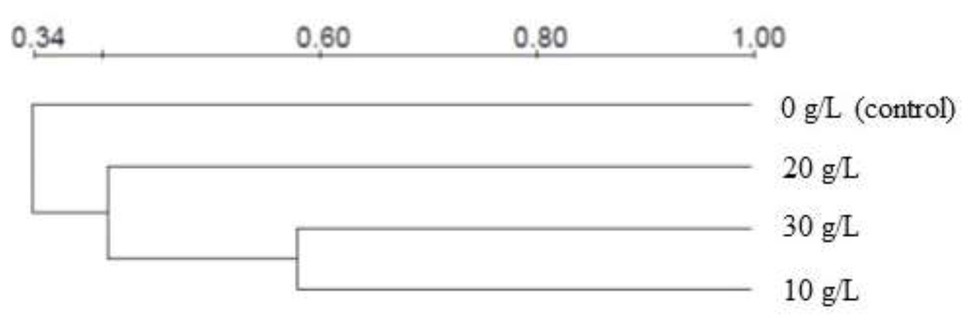
Figure 5. Clustering analysis for evaluating the similarity between microbial communities at different NaCl concentrations.
Microbial Dynamic Implications
According to the findings in this study, the hydrolytic bacteria and acidogens were enriched with the presence of NaCl, especially at the optimal NaCl concentration of 20 g/L, which facilitated the hydrolysis stage and acidification stages. In contrast, the bacteria responsible for SCFAs consumption and methane production were inhibited with decreased abundance due to the attack of high salinity condition on SCFAs-consuming bacteria, which was beneficial for reducing SCFAs consumption and facilitating SCFAs accumulation in anaerobic fermentation. Moreover, the increased protease activity and decreased α-glucosidase activity with rising NaCl concentration are observed in Figure 1. It could be inferred that the hydrolysis of protein-like substances was improved with NaCl assistance, while the hydrolysis of carbohydrates might be a bit poor. During the NaCl assistant anaerobic fermentation, the bacteria responsible for DOMs biodegradation and SCFAs production were enriched, these bacteria were resistant to high NaCl concentration. On contrary, the SCFAs consumers (e.g., methanogens, etc.) were inhibited, which were vulnerable to high salinity condition. Obviously, the external NaCl modified microbial community structure by richness, diversity, and evenness, which created a liquid environment favorable for acidogenic fermentation.
Although the optimal NaCl concentration of 20 g/L was high, the NaCl could be recovered and reused after utilization of the produced SCFAs in fermentative liquid, which reduced the treatment costs and environmental hazard. The fermentative liquid could be used as external carbon source for biological electricity production (MFC) or hydrogen production (microbial electrolysis cells). In this way, the effluent with numerous NaCl could be reused for NaCl assistant anaerobic fermentation process.
Conclusion
This study demonstrated that NaCl could modify hydrolase activity and microbial community structure in 4-day anaerobic fermentation. With the rising NaCl concentrations (0–30 g/L), the protease activity was increased to 127.6–160%, while the α-glucosidase activity was reduced to 76.1–86.2%. Some carbohydrate-hydrolysis bacteria (e.g., Parabacteroides chartae, Macellibacteroides fermentans, and Petrimonas mucosa) were inhibited by high salinity condition, while the protein-degrading and SCFAs-producing bacteria were resistive and enriched. Compared with control test, the microbial community richness and diversity were reduced in NaCl test (10–30 g/L), while the evenness was almost changeless. The similarity between communities was low. Moreover, the pathway of DOMs biodegradation and SCFAs production in NaCl assistant anaerobic fermentation was illustrated.
Data Availability Statement
The raw data supporting the conclusions of this article will be made available by the authors, without undue reservation.
Author Contributions
HP: writing-original draft and data curation. XX: investigation. ZY: methodology. BC: writing-original draft. CL: data curation. XW: software. DG: writing-original draft, conceptualization, and formal analysis. JH: supervision. JN: conceptualization. All authors contributed to the article and approved the submitted version.
Funding
Thanks for the support from National Natural Science Foundation of China – China (No.51778179) and National key research and development program of China – China (2018YFD1100603).
Conflict of Interest
CL was employed by the company Frog Biotechnology Co., LTD, Harbin, 350116, China.
The remaining authors declare that the research was conducted in the absence of any commercial or financial relationships that could be construed as a potential conflict of interest.
Acknowledgments
The authors thank the funders, and Dr. Qin for the support and enlightenment.
References
Brune, A., Ludwig, W., and Schink, B. (2002). Propionivibrio limicola sp. nov., a fermentative bacterium specialized in the degradation of hydroaromatic compounds, reclassification of Propionibacter pelophilus as Propionivibrio pelophilus comb. nov. and amended description of the genus Propionivibrio. Int. J. Syst. Evol. Microbiol. 52, 441–444. doi: 10.1099/00207713-52-2-441
Cai, M. M., Chua, H., Zhao, Q. L., Shirley, S. N., and Ren, J. (2009). Optimal production of polyhydroxyalkanoates (PHA) in activated sludge fed by volatile fatty acids (VFAs) generated from alkaline excess sludge fermentation. Bioresour. Technol. 100, 1399–1405. doi: 10.1016/j.biortech.2008.09.014
Chen, Y., Luo, J., Yan, Y., and Feng, L. (2013). Enhanced production of short-chain fatty acid by co-fermentation of waste activated sludge and kitchen waste under alkaline conditions and its application to microbial fuel cells. Appl. Energy 102, 1197–1204. doi: 10.1016/j.apenergy.2012.06.056
Chen, Y., Zhu, R., Jiang, Q., Sun, T., Li, M., Shi, J., et al. (2019). Effects of green waste participation on the co-digestion of residual sludge and kitchen waste: a preliminary study. Sci. Total Environ. 671, 838–849. doi: 10.1016/j.scitotenv.2019.03.339
Cheng, Q., Xu, C., Huang, W., Jiang, M., Yan, J., Fan, G., et al. (2020). Improving anaerobic digestion of piggery wastewater by alleviating stress of ammonia using biochar derived from rice straw. Environ. Technol. Innov. 19:100948. doi: 10.1016/j.eti.2020.100948
Cui, Y., Su, H., Chen, Y., Chen, Y., and Peng, Y. (2015). Mechanism of activated sludge Floc disintegration induced by excess addition of NaCl. Clean (Weinh) 43, 1197–1206. doi: 10.1002/clen.201400219
Duan, X., Wang, X., Xie, J., Feng, L., Yan, Y., and Zhou, Q. (2016). Effect of nonylphenol on volatile fatty acids accumulation during anaerobic fermentation of waste activated sludge. Water Res. 105, 209–217. doi: 10.1016/j.watres.2016.08.062
Garcia, S. L., Jangid, K., Whitman, W. B., and Das, K. C. (2011). Transition of microbial communities during the adaption to anaerobic digestion of carrot waste. Bioresour. Technol. 102, 7249–7256. doi: 10.1016/j.biortech.2011.04.098
Han, X., Wang, Z., Ma, J., Zhu, C., Li, Y., and Wu, Z. (2015). Membrane bioreactors fed with different COD/N ratio wastewater: impacts on microbial community, microbial products, and membrane fouling. Environ. Sci. Pollut. Res. 22, 11436–11445. doi: 10.1007/s11356-015-4376-z
He, Z. W., Liu, W. Z., Gao, Q., Tang, C. C., Wang, L., Guo, Z. C., et al. (2018). Potassium ferrate addition as an alternative pre-treatment to enhance short-chain fatty acids production from waste activated sludge. Bioresour. Technol. 247, 174–181. doi: 10.1016/j.biortech.2017.09.073
He, Z. W., Tang, C. C., Liu, W. Z., Ren, Y. X., Guo, Z. C., Zhou, A. J., et al. (2019). Enhanced short-chain fatty acids production from waste activated sludge with alkaline followed by potassium ferrate treatment. Bioresour. Technol. 289:121642. doi: 10.1016/j.biortech.2019.121642
Huang, X., Shen, C., Liu, J., and Lu, L. (2015). Improved volatile fatty acid production during waste activated sludge anaerobic fermentation by different bio-surfactants. Chem. Eng. J. 264, 280–290. doi: 10.1016/j.cej.2014.11.078
Ji, B., Zhang, M., Gu, J., Ma, Y., and Liu, Y. (2020). A self-sustaining synergetic microalgal-bacterial granular sludge process towards energy-efficient and environmentally sustainable municipal wastewater treatment. Water Res. 179:115884. doi: 10.1016/j.watres.2020.115884
Kim, S., Seol, E., Oh, Y. -K., Wang, G. Y., and Park, S. (2009). Hydrogen production and metabolic flux analysis of metabolically engineered Escherichia coli strains. Int. J. Hydrog. Energy 34, 7417–7427. doi: 10.1016/j.ijhydene.2009.05.053
Kodama, Y., Shimoyama, T., and Watanabe, K. (2012). Dysgonomonas oryzarvi sp. nov., isolated from a microbial fuel cell. Int. J. Syst. Evol. Microbiol. 62, 3055–3059. doi: 10.1099/ijs.0.039040-0
Lawson, P., Dainty, R. H., Kristiansen, N., Berg, J., and Collins, M. D. (1994). Characterization of a psychrotrophic Clostridium causing spoilage in vacuum-packed cooked pork: description of Clostridium algidicarnis sp. nov. Lett. Appl. Microbiol. 19, 153–157. doi: 10.1111/j.1472-765x.1994.tb00930.x
Lee, S., Park, S., Park, C., Pack, S. P., and Lee, J. (2014). Enhanced free fatty acid production by codon-optimized Lactococcus lactis acyl-ACP thioesterase gene expression in Escherichia coli using crude glycerol. Enzym. Microb. Technol. 67, 8–16. doi: 10.1016/j.enzmictec.2014.08.004
Li, X., Chen, H., Hu, L., Yu, L., Chen, Y., and Gu, G. (2011). Pilot-scale waste activated sludge alkaline fermentation, fermentation liquid separation, and application of fermentation liquid to improve biological nutrient removal. Environ. Sci. Technol. 45, 1834–1839. doi: 10.1021/es1031882
Li, X., Chen, L., Mei, Q., Dong, B., Dai, X., Ding, G., et al. (2018). Microplastics in sewage sludge from the wastewater treatment plants in China. Water Res. 142, 75–85. doi: 10.1016/j.watres.2018.05.034
Liu, K., Chen, Y., Xiao, N., Zheng, X., and Li, M. (2015). Effect of humic acids with different characteristics on fermentative short-chain fatty acids production from waste activated sludge. Environ. Sci. Technol. 49, 4929–4936. doi: 10.1021/acs.est.5b00200
Lu, H., Li, Y., Shan, X., Abbas, G., Zeng, Z., Kang, D., et al. (2019). A holistic analysis of ANAMMOX process in response to salinity: from adaptation to collapse. Sep. Purif. Technol. 215, 342–350. doi: 10.1016/j.seppur.2019.01.016
Luo, K., Pang, Y., Yang, Q., Wang, D., Li, X., Lei, M., et al. (2019). A critical review of volatile fatty acids produced from waste activated sludge: enhanced strategies and its applications. Environ. Sci. Pollut. Res. 26, 13984–13998. doi: 10.1007/s11356-019-04798-8
Lv, W., Schanbacher, F. L., and Yu, Z. T. (2010). Putting microbes to work in sequence: recent advances in temperature-phased anaerobic digestion processes. Bioresour. Technol. 101, 9409–9414. doi: 10.1016/j.biortech.2010.07.100
Miura, Y., Hiraiwa, M. N., Ito, T., Itonaga, T., Watanabe, Y., and Okabe, S. (2007). Bacterial community structures in MBRs treating municipal wastewater: relationship between community stability and reactor performance. Water Res. 41, 627–637. doi: 10.1016/j.watres.2006.11.005
Pang, H., Chen, Y., He, J., Guo, D., Pan, X., Ma, Y., et al. (2020a). Cation exchange resin-induced hydrolysis for improving biodegradability of waste activated sludge: characterization of dissolved organic matters and microbial community. Bioresour. Technol. 302:122870. doi: 10.1016/j.biortech.2020.122870
Pang, H., He, J., Ma, Y., Pan, X., Zheng, Y., Yu, H., et al. (2021). Enhancing volatile fatty acids production from waste activated sludge by a novel cation-exchange resin assistant strategy. J. Clean. Prod. 278:123236. doi: 10.1016/j.jclepro.2020.123236
Pang, H., Li, L., He, J., Yan, Z., Ma, Y., Nan, J., et al. (2020b). New insight into enhanced production of short-chain fatty acids from waste activated sludge by cation exchange resin-induced hydrolysis. Chem. Eng. J. 388:124235. doi: 10.1016/j.cej.2020.124235
Pang, H., Ma, W., He, J., Pan, X., Ma, Y., Guo, D., et al. (2020c). Hydrolase activity and microbial community dynamic shift related to the lack in multivalent cations during cation exchange resin-enhanced anaerobic fermentation of waste activated sludge. J. Hazard. Mater. 398:122930. doi: 10.1016/j.jhazmat.2020.122930
Pang, H., Pan, X., Li, L., He, J., Zheng, Y., Qu, F., et al. (2020d). An innovative alkaline protease-based pretreatment approach for enhanced short-chain fatty acids production via a short-term anaerobic fermentation of waste activated sludge. Bioresour. Technol. 312:123397. doi: 10.1016/j.biortech.2020.123397
Pang, H., Xu, J., He, J., Pan, X., Ma, Y., Li, L., et al. (2020e). Enhanced anaerobic fermentation of waste activated sludge by NaCl assistant hydrolysis strategy: improved bio-production of short-chain fatty acids and feasibility of NaCl reuse. Bioresour. Technol. 312:123303. doi: 10.1016/j.biortech.2020.123303
Polli, F., Zingaretti, D., Crognale, S., Pesciaroli, L., D’Annibale, A., Petruccioli, M., et al. (2018). Impact of the Fenton-like treatment on the microbial community of a diesel-contaminated soil. Chemosphere 191, 580–588. doi: 10.1016/j.chemosphere.2017.10.081
Reid, E., Liu, X., and Judd, S. J. (2006). Effect of high salinity on activated sludge characteristics and membrane permeability in an immersed membrane bioreactor. J. Membr. Sci. 283, 164–171. doi: 10.1016/j.memsci.2006.06.021
Soutschek, E., Winter, J., Schindler, F., and Kandler, O. (1984). Acetomicrobium flavidum, gen. Nov., sp. nov., a thermophilic, anaerobic bacterium from sewage sludge, forming acetate, CO2 and H2 from glucose. System 5, 377–390. doi: 10.1016/S0723-2020(84)80039-9
Su, G., Wang, S., Yuan, Z., and Peng, Y. (2016). Enhanced volatile fatty acids production of waste activated sludge under salinity conditions: performance and mechanisms. J. Biosci. Bioeng. 121, 293–298. doi: 10.1016/j.jbiosc.2015.07.009
Sun, R., Zhou, A., Jia, J., Liang, Q., Liu, Q., Xing, D., et al. (2015). Characterization of methane production and microbial community shifts during waste activated sludge degradation in microbial electrolysis cells. Bioresour. Technol. 175, 68–74. doi: 10.1016/j.biortech.2014.10.052
Tan, H. Q., Li, T. T., Zhu, C., Zhang, X. Q., Wu, M., and Zhu, X. F. (2012). Parabacteroides chartae sp. nov., an obligately anaerobic species from wastewater of a paper mill. Int. J. Syst. Evol. Microbiol. 62, 2613–2617. doi: 10.1099/ijs.0.038000-0
Wang, L., He, Z., Guo, Z., Sangeetha, T., Yang, C., Gao, L., et al. (2019). Microbial community development on different cathode metals in a bioelectrolysis enhanced methane production system. J. Power Sources 444:227306. doi: 10.1016/j.jpowsour.2019.227306
Wittebolle, L., Boon, N., Vanparys, B., Heylen, K., Vos, P. D., and Verstraete, W. (2005). Failure of the ammonia oxidation process in two pharmaceutical wastewater treatment plants is linked to shifts in the bacterial communities. J. Appl. Microbiol. 99, 997–1006. doi: 10.1111/j.1365-2672.2005.02731.x
Xin, X. D., He, J. G., Qiu, W., Tang, J., and Liu, T. T. (2015). Microbial community related to lysozyme digestion process for boosting waste activated sludge biodegradability. Bioresour. Technol. 175, 112–119. doi: 10.1016/j.biortech.2014.10.042
Xin, S., Shen, J., Liu, G., Chen, Q., Xiao, Z., Zhang, G., et al. (2020). Electricity generation and microbial community of single-chamber microbial fuel cells in response to Cu2O nanoparticles/reduced graphene oxide as cathode catalyst. Chem. Eng. J. 380:122446. doi: 10.1016/j.cej.2019.122446
Xu, F., Cao, F., Kong, Q., Zhou, L., Yuan, Q., Zhu, Y., et al. (2018). Electricity production and evolution of microbial community in the constructed wetland-microbial fuel cell. Chem. Eng. J. 339, 479–486. doi: 10.1016/j.cej.2018.02.003
Xu, F., Ouyang, D., Rene, E. R., Ng, H. Y., Guo, L., Zhu, Y., et al. (2019). Electricity production enhancement in a constructed wetland-microbial fuel cell system for treating saline wastewater. Bioresour. Technol. 288:121462. doi: 10.1016/j.biortech.2019.121462
Zhang, M., Gu, J., and Liu, Y. (2019). Engineering feasibility, economic viability and environmental sustainability of energy recovery from nitrous oxide in biological wastewater treatment plant. Bioresour. Technol. 282, 514–519. doi: 10.1016/j.biortech.2019.03.040
Zhang, Q., Wang, L., Yu, Z., Zhou, T., Gu, Z., Huang, Q., et al. (2020). Pine sawdust as algal biofilm biocarrier for wastewater treatment and algae-based byproducts production. J. Clean. Prod. 256:120449. doi: 10.1016/j.jclepro.2020.120449
Keywords: sodium chloride, anaerobic fermentation, hydrolase activity, waste activated sludge, microbial community
Citation: Pang H, Xin X, He J, Cui B, Guo D, Liu S, Yan Z, Liu C, Wang X and Nan J (2020) Effect of NaCl Concentration on Microbiological Properties in NaCl Assistant Anaerobic Fermentation: Hydrolase Activity and Microbial Community Distribution. Front. Microbiol. 11:589222. doi: 10.3389/fmicb.2020.589222
Edited by:
Qiang Kong, Shandong Normal University, ChinaReviewed by:
Qinglian Wu, National University of Singapore, SingaporeGuozhi Fan, Wuhan Polytechnic University, China
Shihai Deng, National University of Singapore, Singapore
Copyright © 2020 Pang, Xin, He, Cui, Guo, Liu, Yan, Liu, Wang and Nan. This is an open-access article distributed under the terms of the Creative Commons Attribution License (CC BY). The use, distribution or reproduction in other forums is permitted, provided the original author(s) and the copyright owner(s) are credited and that the original publication in this journal is cited, in accordance with accepted academic practice. No use, distribution or reproduction is permitted which does not comply with these terms.
*Correspondence: Dabin Guo, ZGFiaW5AaHVzdC5lZHUuY24=
 Heliang Pang2
Heliang Pang2 Junguo He
Junguo He Dabin Guo
Dabin Guo Zhongsen Yan
Zhongsen Yan